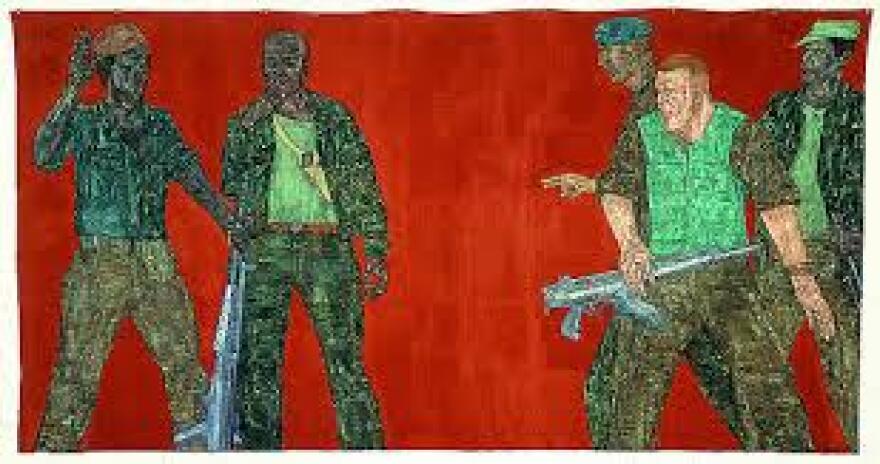There are new details in the strange story of a former Franklin Pierce University art professor and her son who stand accused of selling forged paintings to a millionaire collector.
Hundreds of pages of court paperwork were recently released as the two sides prepare for a trail this summer, including an expert analysis of the paintings' authenticity.
NHPR’s Todd Bookman has been digging into them, and joins All Things Considered host Peter Biello in studio for an update.
[Editor’s note: this transcript has been edited for clarity.]
This case involves the Gascards, a mother and son who live in the Monadnock region, and a prolific art collector named Andrew Hall. What does Hall say happened?
Prolific is right. Hall owns between 5,000-6,000 works of art. One artist who he likes to collect is a now deceased New York-based painter named Leon Golub.
In 2009, Hall purchased a few Golubs through auctions at well-known houses Christie’s and Sotheby's. It turns out those paintings were put up for auction by Nikolas Gascard. He’s the son of Lorettann Gascard, who is herself an artist and at that time was a professor at Franklin Pierce University in Rindge, New Hampshire.
After those initial sales, Nikolas Gascard reached out to Hall directly and said he had inherited a large cache of Leon Golubs. He offered to sell some of them directly to Hall.
Cut out the middleman…
Right. These two then completed two separate sales, one invoiced to Nikolas, one invoiced to Lorettann, totaling more than $400,000. In total, Hall bought 24 works by Leon Golub from the Gascards, who were living in Rindge at this time.
But are those works actually by Leon Golub?
Well, it doesn’t appear so. There was some initial suspicion raised when a gallery that Hall owns in Vermont was preparing an exhibition of some of his Golub paintings. The gallery reached out to the estate of Leon Golub to verify the names, dates, and materials in the paintings. But the estate responded that it didn’t recognize or have information for 24 of the paintings in the show--all 24 were the works Hall purchased from the Gascards.
In this new release of court records, there is a report from Jon Bird, the world’s leading expert on Leon Golub, who inspected the 24 paintings in person.
His report concludes that in his opinion, none of the paintings were done by Golub’s hand. He describes these works as clumsy, lacking Golub’s skill, and they also don’t appear to be painted in the technique Golub used.
So if Leon Golub didn’t paint these paintings, who did?
That’s a good question. And that’s where Nikolas Gascard’s mother, Lorettann, comes in.
Apparently, Hall has a quote “strong suspicion” that Lorettann Gascard painted them herself, according to court records. Afterall, she’s an artist in her own right, and was also a student of Leon Golub’s in the 1960s. The two apparently maintained some level of communication over the years.
I should note there is no evidence that Lorettann painted then, but it’s an interesting revelation that Hall is of the belief she did.
The defendants, the Gascards, are asking the court to throw this suit out. They say the statute of limitations has passed and that Hall, as a sophisticated collector, should have had experts review the canvasses when he purchased them, not several years later.
Exactly, they contend the buyer, especially one as prolific as Hall, has a duty to make a timely inspection regarding the authenticity of the works. They believe the statute of limitations to bring this claim has expired.
Hall’s lawyers dispute that and point to previous cases that they believe show there is no requirement that an art collector verify the authenticity of works at the time of the sale.
In hindsight, Hall does admit that, if you think about it, it is a bit odd that here’s this huge stash of Leon Golub paintings sitting in rural New Hampshire.
The Federal Court judge hasn’t yet ruled on the Gascard’s motion to throw the case out.
There is one other peculiar new bit of information that came out in the released documents, and that’s that Nikolas Gascard apparently used fake names for some of his contacts with the art world. He in fact used two different pseudonyms, Larry Devlin and Art Thoreau, to bid on his own mother’s artwork during one online auction. It’s just another strange detail in a very strange New Hampshire story.







